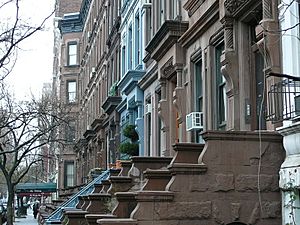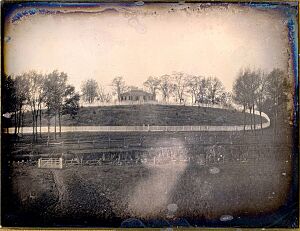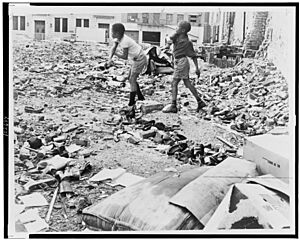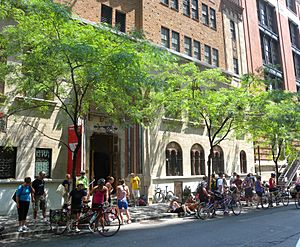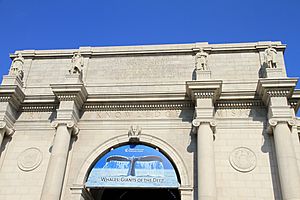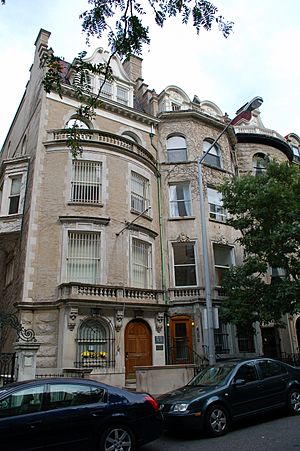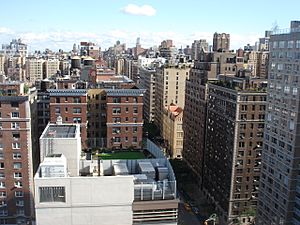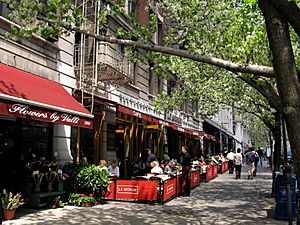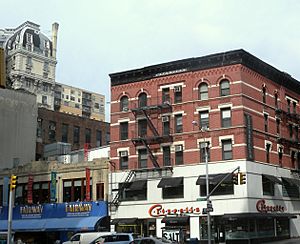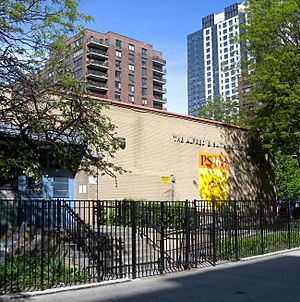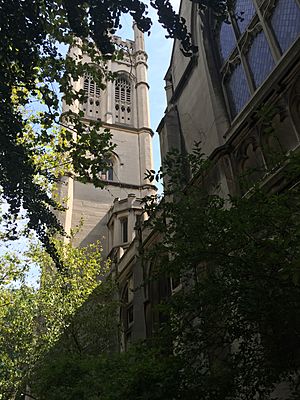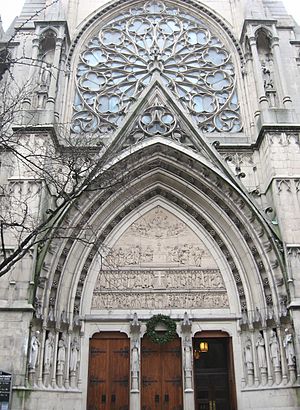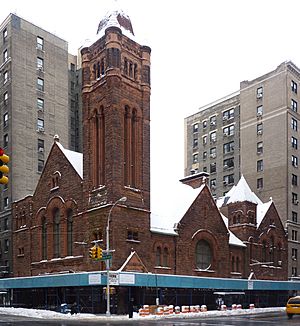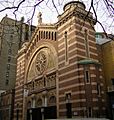Upper West Side facts for kids
Quick facts for kids
Upper West Side
|
|
|---|---|
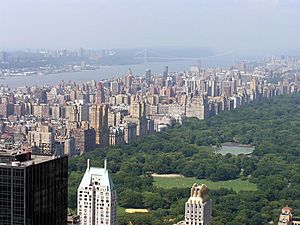
The Upper West Side and Central Park as seen from Top of the Rock observatory at Rockefeller Center. In the background to the west are the Hudson River and the George Washington Bridge.
|
|
| Nickname(s):
UWS
|
|
| Country | |
| State | |
| City | New York City |
| Borough | Manhattan |
| Community District | Manhattan 7 |
| Area | |
| • Total | 5 km2 (1.9 sq mi) |
| Population
(2018)
|
|
| • Total | 214,744 |
| • Density | 43,600/km2 (113,000/sq mi) |
| Ethnicity | |
| • White | 67.4% |
| • Black | 7.6 |
| • Asian | 7.6 |
| • Others | 17.4 |
| Economics | |
| • Median income | $121,032 |
| Time zone | UTC−5 (Eastern) |
| • Summer (DST) | UTC−4 (EDT) |
| ZIP Codes |
10023, 10024, 10025, 10069
|
| Area code | 212, 332, 646, and 917 |
The Upper West Side (UWS) is a neighborhood in the borough of Manhattan in New York City. It is bordered by Central Park to the east and the Hudson River to the west. To the south, it reaches West 59th Street, and to the north, it extends to West 110th Street.
The Upper West Side is next to Hell's Kitchen in the south, Columbus Circle in the southeast, and Morningside Heights in the north. Like the Upper East Side, it is a wealthy, mostly residential area. Many people who live here work in the business districts of Midtown and Lower Manhattan.
This neighborhood is also a center for culture and learning. You can find Columbia University and Barnard College just north of the area. The American Museum of Natural History is in the middle of the Upper West Side. Also, Lincoln Center for the Performing Arts and Fiorello H. LaGuardia High School are at the southern end. The Upper West Side is part of Manhattan Community District 7. Its main ZIP Codes are 10023, 10024, 10025, and 10069.
Contents
- Exploring the Upper West Side's Geography
- A Look at the Upper West Side's History
- Understanding the Upper West Side's Population
- Important Buildings and Places
- Fire Safety Services
- Post Offices and ZIP Codes
- Education in the Upper West Side
- Places of Worship
- Getting Around: Transportation
- The Upper West Side in Movies and TV
- See also
Exploring the Upper West Side's Geography
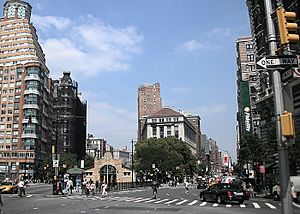
The Upper West Side is bordered by 59th Street to the south. Central Park is on its east side, and the Hudson River is on its west side. The neighborhood goes up to 110th Street in the north. The area north of West 96th Street and east of Broadway is also known as Manhattan Valley.
The main avenues in the Upper West Side run from west to east. They are Riverside Drive, West End Avenue, Broadway, Amsterdam Avenue, Columbus Avenue, and Central Park West. Broadway runs diagonally through the southern part of the neighborhood. North of 78th Street, Broadway runs straight, parallel to the other avenues.
Broadway starts at Columbus Circle (59th Street) where it meets Central Park West. It crosses Columbus Avenue at Lincoln Square (65th Street). Then it crosses Amsterdam Avenue at Verdi Square (71st Street). Finally, it joins West End Avenue at Straus Park (107th Street).
The neighborhood's boundaries have changed over time. The area from 58th Street to 65th Street is now often called Lincoln Square. This is because of new buildings like the Time Warner Center and the Riverside South apartments. This part of the neighborhood has a different feel from the rest of the Upper West Side.
A Look at the Upper West Side's History
Long ago, the Lenape people did not use the high land above the North River much. In the 1700s and early 1800s, some of New York's biggest houses were built here along Bloomingdale Road. Later, smaller homes were added. By the mid-1800s, some parts of the area became less wealthy.
The Bloomingdale District's Past
The "Bloomingdale District" was a name for a part of the Upper West Side. This area is now called Manhattan Valley. It was between 96th and 110th Streets, from Amsterdam Avenue to the Hudson River.
The name "Bloomingdale" came from the Dutch settlers. It likely came from "Bloemendaal," a town in the Netherlands known for tulips. The Bloomingdale Road was a main path through this area. It started near Union Square and went north to about 116th Street. Along this road were farms and country homes.
In the 1800s, the Croton Aqueduct was built through the area. This divided the northern part into Manhattan Valley to the east and Bloomingdale to the west. By the late 1800s, Bloomingdale was a village just south of 110th Street.
Growth in the Late 1800s
Much of the Upper West Side's riverfront was used for shipping and factories. The Hudson River Railroad line was built along the river in the 1830s. When Central Park was created in the 1850s and 1860s, many people moved their small homes into the Upper West Side. This made some parts of the neighborhood a mix of simple houses and lively taverns.
The old Bloomingdale Road was renamed "Western Boulevard" or "The Boulevard" in 1868. It kept this name until the end of the century when it became Broadway.
Development was slow at first, especially after the Panic of 1873. But things changed with the Ninth Avenue elevated train in the 1870s. Also, Columbia University moved to Morningside Heights in the 1890s.
Riverside Park was planned in 1866. The first part of the park was bought in 1872. Construction began with a design by Frederick Law Olmsted, who also designed the nearby Riverside Drive. In 1937, more land was added to the park. A walkway was built over the Hudson River Railroad tracks. Playgrounds and stone work were also added.
Later in the 20th century, Riverside Park was improved by a group of citizens. The Hudson River Greenway along the river is a popular path for walking and biking.
Early 1900s Changes
Subway Expansion and Building Boom
In 1868, the IRT Ninth Avenue Line opened. This was the city's first elevated railway. The Upper West Side then saw a lot of new buildings from 1885 to 1910. This was largely thanks to the first subway line opening in 1904. This line is now part of the IRT Broadway–Seventh Avenue Line. It had stations at 59th, 66th, 72nd, 79th, 86th, 91st, 96th, 103rd, 110th, 116th, and 125th Streets.
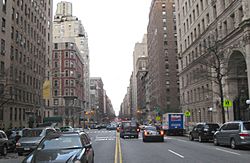
The subway helped more homes to be built. The grand apartment buildings on West End Avenue and the townhouses between Amsterdam Avenue and Riverside Drive were all built before the 1930s. New building methods, cheaper land, and elevators made it possible to build large apartment buildings for many people. The size and style of these buildings are why the neighborhood looks much the same today.
The neighborhood changed more from the 1930s to the 1950s. In 1932, the IND Eighth Avenue Line opened under Central Park West. In 1940, the elevated IRT Ninth Avenue Line closed. New people from Eastern Europe and the Caribbean moved in during the 1950s and 1960s. The Lincoln Center for the Performing Arts opened in the 1960s.
Special Areas in the Neighborhood
In the early 1900s, the area south of 67th Street had many African-American residents. This area was sometimes called "San Juan Hill." By 1960, it was an older neighborhood with many tenement buildings. These buildings were later torn down to build the Lincoln Center for the Performing Arts and Lincoln Towers apartments between 1962 and 1968.
The Upper West Side is also an important Jewish neighborhood. Many German Jews moved here around 1900. Later, Jewish refugees escaping Europe in the 1930s also settled here. Today, the area between 85th and 100th Streets has a large community of young Modern Orthodox Jewish people. Many important synagogues are in the neighborhood, including Congregation Shearith Israel, the oldest Jewish congregation in the United States.
Late 20th-Century Development
After World War II, the rail yards in the southwest part of the Upper West Side were replaced. This area became the Riverside South residential project. It also included an extension of Riverside Park. This project took 40 years to develop.
The name Bloomingdale is still used for a part of the Upper West Side. This area is from about 96th Street to 110th Street, and from Riverside Park to Amsterdam Avenue. The triangular block at Broadway, West End Avenue, 106th Street, and 107th Street is known as Straus Park. The neighborhood also has the Bloomingdale School of Music and a New York Public Library branch. Next to Bloomingdale is Manhattan Valley, a more diverse area.
Understanding the Upper West Side's Population
The Upper West Side is part of two census areas: Upper West Side (up to 105th Street) and Lincoln Square (down to 58th Street). In 2010, the total population was 193,867. The area is about 1,162.29 acres (470.36 ha) large.
The racial makeup of the neighborhood in 2010 was about 69.5% White, 7.1% African American, 7.6% Asian, and 13.3% Hispanic or Latino. The number of Asian residents increased, while the number of Black residents decreased. The White population remained the majority.
Most residents are adults. About 34% are between 25 and 44 years old, and 27% are between 45 and 64. About 18% are 65 or older. The Upper West Side has a higher rate of college-educated residents than the rest of New York City. About 78% of adults aged 25 and older have a college education or higher.
Important Buildings and Places
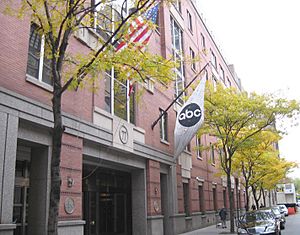
Company Headquarters
- American Broadcasting Company (ABC) has its main office at 77 West 66th Street.
- Time Warner's headquarters are on Columbus Circle.
- Two main music licensing groups, ASCAP and BMI, are in the neighborhood.
- Lighthouse Guild, an organization helping people with vision problems, has its national headquarters on West 64th Street.
Cultural Places to Visit
- American Folk Art Museum
- American Museum of Natural History
- Ballet Hispanico
- Beacon Theatre
- Children's Museum of Manhattan
- Lincoln Center – This is a large center for performing arts. It has 12 different companies and many theaters.
- Metropolitan Opera
- David Geffen Hall, home of the New York Philharmonic
- David H. Koch Theater, home of the New York City Ballet
- Juilliard School of Music
- Jazz at Lincoln Center
- New-York Historical Society
- Nicholas Roerich Museum
- Symphony Space
Homes and Buildings
The apartment buildings along Central Park West are very grand. The Dakota at 72nd Street has been home to many famous people like John Lennon. Other famous buildings on Central Park West include The Century, Majestic, the San Remo, and El Dorado.
Along Broadway, you can find large apartment buildings like the Belnord, the Apthorp, the Ansonia, and the Dorilton. Many of these are considered New York City landmarks. Riverside Drive also has many beautiful old homes and buildings. West End Avenue is lined with apartment buildings and townhouses from the late 1800s and early 1900s.
Places to Eat and Shop for Food
Broadway and Amsterdam Avenue, from 67th Street to 110th Street, have many restaurants and bars. Columbus Avenue also has some. Here are a few well-known spots:
- Barney Greengrass, known for fish, at Amsterdam Avenue and 86th Street.
- Citarella Gourmet Market, a flagship store for seafood and gourmet foods, at 75th Street.
- Cafe Lalo, a dessert and coffee spot at 83rd Street and Amsterdam Avenue. It opened in 1988 and was featured in the movie You've Got Mail.
- A branch of Gray's Papaya, famous for hot dogs, is at Broadway and 72nd Street.
- The original Zabar's is a specialty food and housewares store at Broadway and 80th Street.
- Tom's Restaurant, at 2880 Broadway, was used for the outside shots of Monk's Cafe in the TV show Seinfeld.
Fire Safety Services
The Upper West Side is protected by several New York City Fire Department (FDNY) fire stations:
- Engine Company 40/Ladder Company 35 – 131 Amsterdam Avenue
- Ladder Company 25/Division 3/Collapse Rescue 1 – 205 West 77th Street
- Engine Company 74 – 120 West 83rd Street
- Engine Company 76/Ladder Company 22/Battalion 11 – 145 West 100th Street
Post Offices and ZIP Codes
The Upper West Side uses three main ZIP Codes:
- 10023 (south of 76th Street)
- 10024 (between 76th and 91st Streets)
- 10025 (north of 91st Street)
The Riverside South area also uses 10069.
The United States Postal Service has five post offices in the Upper West Side:
- Ansonia Station – 178 Columbus Avenue
- Cathedral Station – 215 West 104th Street
- Columbus Circle Station – 27 West 60th Street
- Park West Station – 700 Columbus Avenue
- Planetarium Station – 127 West 83rd Street
Education in the Upper West Side
The Upper West Side has many residents with college degrees. In 2018, about 78% of people aged 25 and older had a college education or higher. This is more than the average for New York City.
Students in the Upper West Side generally do well in school. The number of elementary school students who miss many days of school is lower than the city average. Also, 83% of high school students here graduate on time, which is higher than the city average.
Local Schools
Public Schools
The New York City Department of Education runs several public elementary schools in the Upper West Side:
- PS 9 Sarah Anderson (grades PK-5)
- PS 75 Emily Dickinson (grades K-5)
- PS 84 Lilian Weber (grades PK-5)
- PS 87 William Sherman (grades PK-5)
- PS 145 The Bloomingdale School (grades PK-5)
- PS 163 Alfred E Smith (grades PK-5)
- PS 165 Robert E Simon (grades PK-8)
- PS 166 The Richard Rogers School of the Arts and Technology (grades K-5)
- PS 191 The Riverside School for Makers and Artists (grades PK-8)
- PS 199 Jessie Isador Straus (grades K-5)
- PS 212 Midtown West (grades PK-5)
- PS 333 Manhattan School For Children (grades K-8)
- PS 452 (grades PK-5)
- PS 811 Mickey Mantle School (grades PK-9)
- Special Music School (grades K-12)
- The Anderson School (grades K-8)
Here are some public middle schools (grades 6-8):
- JHS 54 Booker T Washington
- Mott Hall II
- MS 243 Center School (grades 5–8)
- MS 245 The Computer School
- MS 247 Dual Language Middle School
- MS 250 West Side Collaborative Middle School
- MS 256 Lafayette Academy
- MS 258 Community Action School
- West Prep Academy
And these are some public high schools (grades 9-12):
- Edward A. Reynolds West Side High School
- Fiorello H. LaGuardia High School – a specialized high school for arts
- Martin Luther King Jr. Educational Campus
- High School for Arts Imagination and Inquiry
- High School for Law Advocacy and Community Justice
- High School of Arts and Technology
- Manhattan/Hunter Science High School
- Urban Assembly School for Media Studies
- Special Music School High School
- Louis D. Brandeis High School Campus
- Frank McCourt High School
- Innovation Diploma Plus (grades 10–12)
- The Global Learning Collaborative
- Urban Assembly School for Green Careers
Charter and Private Schools
Many charter and private schools are also in the Upper West Side:
- Abraham Joshua Heschel School
- Alexander Robertson School
- Ascension School (Pre-K3 through 8)
- Bank Street School for Children
- Beit Rabban Day School
- Bloomingdale School of Music
- Calhoun School
- The Collegiate School
- Columbia Grammar & Preparatory School
- Columbus Academy
- Dwight School
- Ethical Culture Fieldston School
- La Salle Academy
- Lucy Moses School
- The Mandell School
- Manhattan Day School
- Rodeph Sholom School
- School of the Blessed Sacrament
- Solomon Schechter School of Manhattan
- St. Agnes Boys High School
- The Studio School
- Success Academy Upper West
- Trevor Day School (Lower)
- Trinity School
- Twin Parks Montessori Schools
- Yeshiva Ketana of Manhattan
- York Preparatory School
Higher Education Opportunities
The Upper West Side and nearby Morningside Heights offer many colleges and universities:
- The Richard Gilder Graduate School at American Museum of Natural History
- The American Musical and Dramatic Academy
- Columbia University – in Morningside Heights
- Bank Street College of Education
- Bard Graduate Center
- Barnard College – one of the Seven Sisters colleges
- Fordham University Lincoln Center campus
- Jewish Theological Seminary of America – in Morningside Heights
- The Juilliard School
- Lander College for Women, part of Touro College
- New York Institute of Technology
- New York Theological Seminary – in Morningside Heights
- William E. Macaulay Honors College
- Manhattan School of Music – in Morningside Heights
- Mannes College The New School for Music
- Teachers College of Columbia University – in Morningside Heights
- Union Theological Seminary – in Morningside Heights
Libraries for Learning
The New York Public Library (NYPL) has four branches in the Upper West Side:
- The New York Public Library for the Performing Arts (LPA) at 40 Lincoln Center Plaza. It has a huge collection about performing arts.
- The Bloomingdale branch at 127 East 58th Street. It opened in 1897.
- The Riverside branch at 127 Amsterdam Avenue. It also opened in 1897.
- The St Agnes branch at 444 Amsterdam Avenue. It started in 1893 and moved to its current building in 1906.
Places of Worship
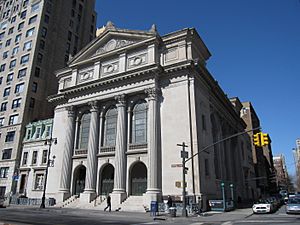
The Upper West Side is home to many different churches and synagogues:
- Fourth Universalist Society in the City of New York – known as the "Cathedral of Universalism." It was founded in 1838.
- The Church of St. Paul the Apostle – a large church at West 60th Street and Columbus Avenue.
- Cathedral of Saint John the Divine – in Morningside Heights. It is planned to be one of the largest Gothic cathedrals in the world.
- Redeemer Presbyterian Church – The West Side church is at 150 West 83rd St.
- First Baptist Church in the City of New York – at 79th Street and Broadway.
- West-Park Presbyterian Church, designed by Leopold Eidlitz.
- Christ and Saint Stephen's Church (Episcopal). Built in 1880.
- The Church of St. Gregory the Great – a Roman Catholic church and school on West 90th Street.
- United Methodist Church of St. Paul & St. Andrew – at West End Avenue and 86th Street.
- The Jewish Center, on West 86th Street.
- Ansche Chesed
- B'nai Jeshurun – a historic Ashkenazi synagogue.
- Congregation Habonim – founded by refugees.
- Congregation Shaare Zedek (New York City) – on West 93rd Street.
- Congregation Shearith Israel – the oldest Jewish congregation in the United States, founded in 1655.
- Congregation Rodeph Sholom – at 83rd Street/Central Park.
- Holy Name of Jesus R.C. Church – at 207 West 96th Street.
- Congregation Ohab Zedek
- Kehilat Orach Eliezer
- Kol Zimrah
- Manhattan New York Temple of the Church of Jesus Christ of Latter-day Saints.
- National Council of Churches – located in the Interchurch Center.
- Riverside Church – in Morningside Heights.
- Rutgers Presbyterian Church – on 236 W. 73rd Street.
- St. Michael's – at Amsterdam Ave and W 99th Street.
- St. Ignatius of Antioch Episcopal Church – at 87th Street and West End Avenue.
- Society for Ethical Culture
- Society for the Advancement of Judaism
- Stephen Wise Free Synagogue
Getting Around: Transportation
Two New York City Subway lines serve the Upper West Side. The IRT Broadway–Seventh Avenue Line (1 2 3 trains) runs under Broadway. The IND Eighth Avenue Line (A, B, C, and D train) runs under Central Park West.
There are also several bus routes that go through the Upper West Side. These include the M5, M7, M10, M11, M104 buses. The M57 bus goes along West End Avenue. Crosstown routes like the M66, M72, M79 SBS, M86 SBS, M96, M106 help people travel east and west. The M20 bus ends at Lincoln Center.
The Upper West Side in Movies and TV
The Upper West Side has been a popular setting for many films and television shows.
Movies Set in the UWS
- American Psycho (2000): The main character lives on West 81st Street.
- Black Swan (2010): The main character, Nina, lives on the Upper West Side.
- Borat: Cultural Learnings of America for Make Benefit Glorious Nation of Kazakhstan (2006): Borat is seen in Columbus Circle.
- Death Wish (1974): The main character lives between Riverside Drive and West End Avenue.
- Die Hard with a Vengeance (1995): A scene takes place outside the 72nd Street subway station.
- Elf (2003): A scene shows Buddy's brother leaving York Prep at 40 West 68th Street.
- Enchanted (2007): Robert and Morgan live on Riverside Drive and 116th Street.
- Extremely Loud & Incredibly Close (2011): The Schell family lives at The Gramont, 215 West 98th Street.
- Eyes Wide Shut (1999): The main characters live in an apartment on Central Park West.
- Fatal Attraction (1987): Michael Douglas' character lives on 100th and West End Avenue.
- Ghostbusters (1984): The characters are professors at Columbia University. Sigourney Weaver's character lives at 55 Central Park West.
- The Goodbye Girl (1977): Filmed at 170 West 78th Street.
- Hannah and Her Sisters (1986): Hannah's parents' apartment is on Riverside and 86th Street.
- Heartburn (1986): Meryl Streep's character stays at the Apthorp on 79th Street and Broadway.
- Home Alone 2: Lost in New York (1992): Parts of the movie take place in Central Park and a townhouse on 95th Street.
- Hitch (2005): Will Smith's character leaves an apartment building at 865 West End Avenue.
- I Am Legend (2007): The Red Cross building at 66th and Amsterdam was used for scenes.
- Little Manhattan (2005): Includes scenes from the American Museum of Natural History and Central Park West.
- Men in Black II (2002): Features the Hayden Planetarium at the American Museum of Natural History.
- The Mirror Has Two Faces (1996): Set in an apartment at 505 West End Avenue.
- Music and Lyrics (2007): Features the area around 72nd Street.
- Night at the Museum (2006): Set in the Museum of Natural History.
- The Odd Couple (1968): Oscar Madison's apartment was at 131 Riverside Drive.
- Panic Room (2002): Takes place on West 94th Street.
- The Panic in Needle Park (1971): Set in Sherman Square, at Broadway and 70th Street.
- Romancing the Stone (1984): Kathleen Turner's character lives on West End Avenue.
- Rosemary's Baby (1968): The Dakota building is shown.
- Single White Female (1992): The Ansonia building is shown.
- Spider-Man (2002): Features Columbia University.
- Spider-Man 2 (2004): Features the Planetarium at the American Museum of Natural History.
- Take the Money and Run (1969): Characters are seen at the fountain in Lincoln Center.
- Three Men and a Baby (1987): Tom Selleck's character's apartment is at The Prasada, 50 Central Park West.
- Vanilla Sky (2001): A car accident happens in Riverside Park.
- Wall Street (1987): Features Central Park and Tavern on the Green.
- The Warriors (1979): Features the 72nd Street subway station and Riverside Park.
- West Side Story (1961): Takes place in old buildings where Lincoln Center is now.
- You've Got Mail (1998): The main characters live on the Upper West Side.
TV Shows Set in the UWS
- Central Park West (1990s): A soap opera about a magazine.
- Gossip Girl: The Empire Hotel, Chuck Bass's hotel, is at 64th Street and Broadway.
- The Marvelous Mrs. Maisel: Mrs. Maisel lives in the Upper West Side.
- The Night Of: A murder in the storyline happens at a residence on the Upper West Side.
- The Odd Couple: Oscar and Felix sometimes give their address as West 74th Street and Central Park West.
- Only Murders in the Building: The show is set in the Belnord building, called "The Arconia."
- Ryan's Hope: The Ryan family lived and owned a bar on the Upper West Side.
- Seinfeld: Jerry Seinfeld's character lived at 129 West 81st Street. The show used real places like Tom's Restaurant.
- Sesame Street: The show's location was inspired by the Upper West Side.
- Will & Grace: Will and Jack live in apartments at 155 Riverside Drive.
Music and Books from the UWS
- "Classical Rap" by Peter Schickele: Describes life on the Upper West Side.
- "Lazy Sunday" by Andy Samberg and Chris Parnell: Mentions seeing a movie at a theater on 68th Street and Broadway.
- "Tom's Diner" by Suzanne Vega: Focuses on a woman at Tom's Restaurant at 112th and Broadway.
- The Tale of the Allergist's Wife, a 1999 play by Charles Busch.
- When You Reach Me, a 2009 novel by Rebecca Stead set in the Upper West Side.
- Rosemary's Baby by Ira Levin.
- The Panic in Needle Park by James Mills.
- The Princess of 72nd Street, a 1979 novel by Elaine Kraf.
- Seize the Day by Saul Bellow.
- Starting Out in the Evening by Brian Morton.
- The Bonfire of the Vanities by Tom Wolfe.
See also
 In Spanish: Upper West Side para niños
In Spanish: Upper West Side para niños


